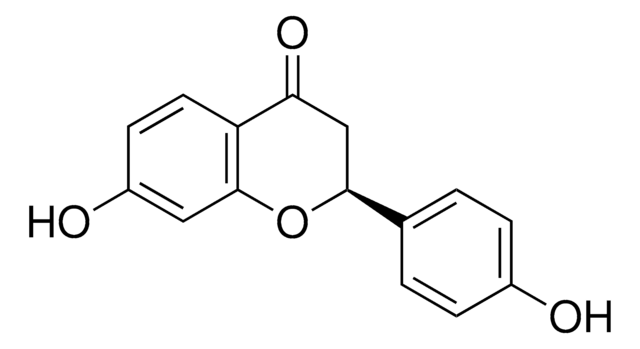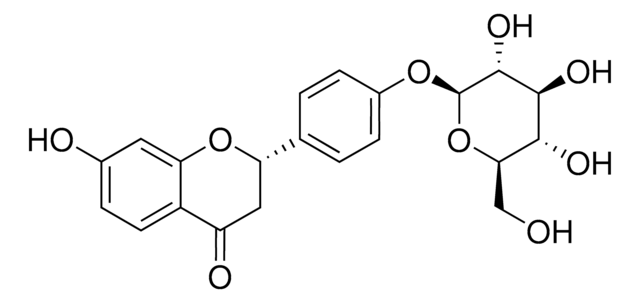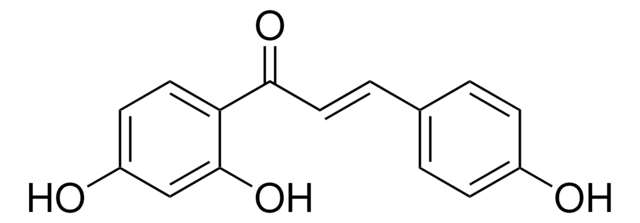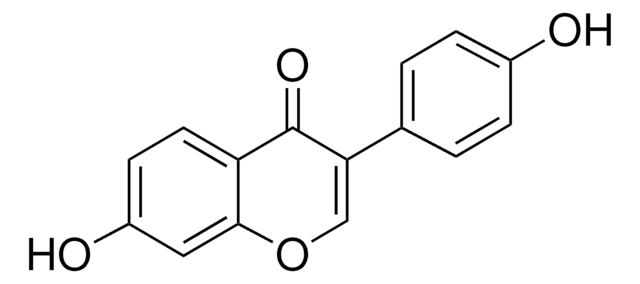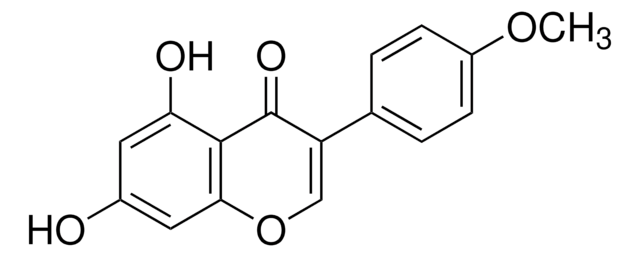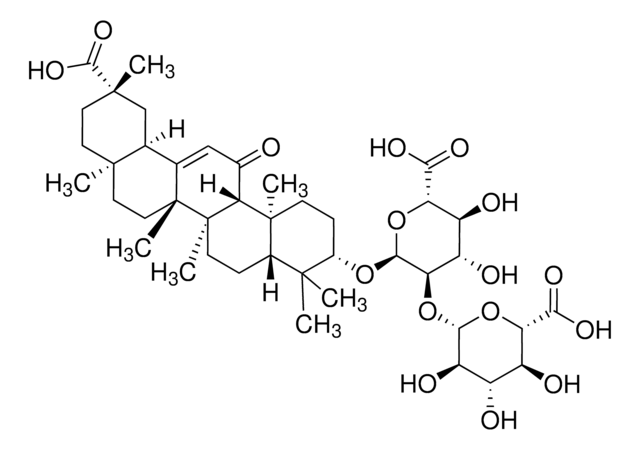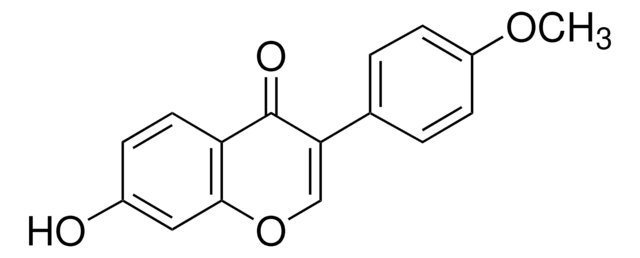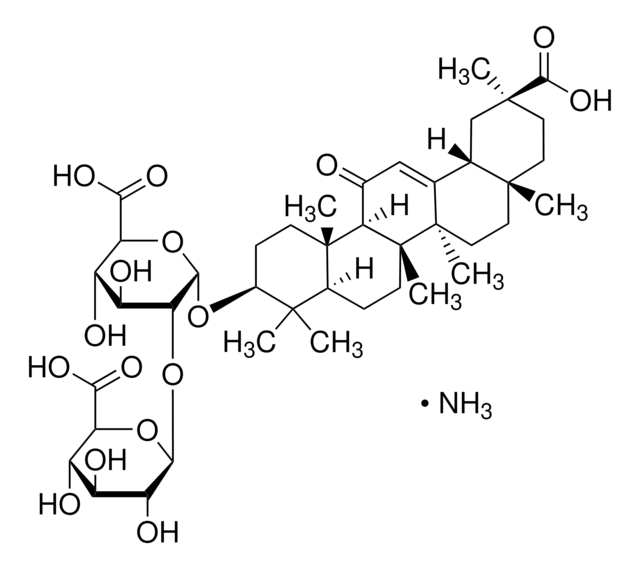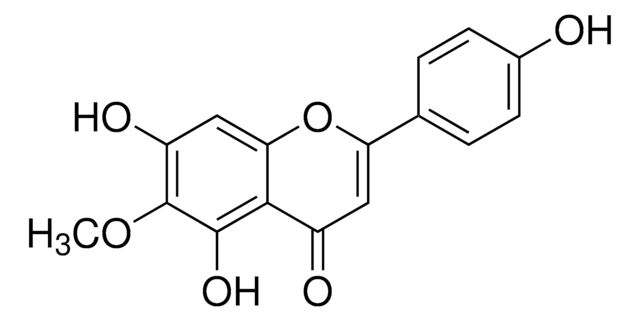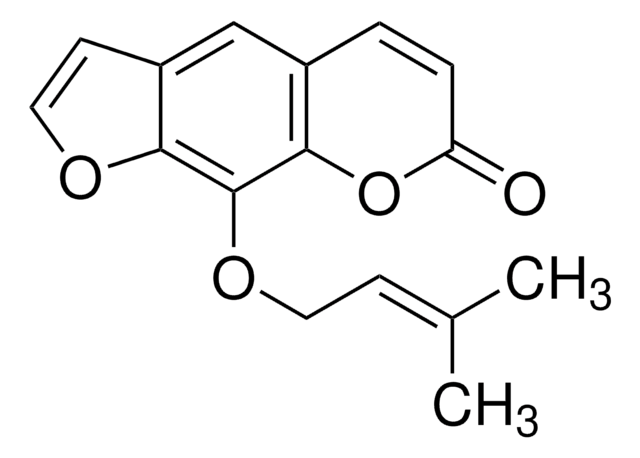78825
Liquiritigenin
≥97.0% (HPLC)
Synonym(s):
7,4′-Dihydroxyflavanone, 7-Hydroxy-2-(4-hydroxyphenyl)-2,3-dihydro-4H-1-benzopyran-4-one
Sign Into View Organizational & Contract Pricing
All Photos(1)
About This Item
Empirical Formula (Hill Notation):
C15H12O4
CAS Number:
Molecular Weight:
256.25
Beilstein:
359378
MDL number:
UNSPSC Code:
12352202
PubChem Substance ID:
NACRES:
NA.28
Recommended Products
Quality Level
Assay
≥97.0% (HPLC)
form
powder or crystals
impurities
≤7% water
application(s)
metabolomics
vitamins, nutraceuticals, and natural products
SMILES string
Oc1ccc(cc1)[C@@H]2CC(=O)c3ccc(O)cc3O2
InChI
1S/C15H12O4/c16-10-3-1-9(2-4-10)14-8-13(18)12-6-5-11(17)7-15(12)19-14/h1-7,14,16-17H,8H2/t14-/m0/s1
InChI key
FURUXTVZLHCCNA-AWEZNQCLSA-N
General description
Liquiritigenin is a flavonoid and an estrogenic compound found in licorice (Glycyrrhizae radix) root extract and several other plants.
Application
Liquiritigenin has been used:
- to study its inhibitory effect on tumor metastasis in the treatment of colorectal cancer
- as a reference standard for ultra-performance liquid chromatography (UPLC) of Chaihu-Shugan-San (CSS) extract
- as a potential antiviral drug against hepatitis C virus (HCV) infection
Biochem/physiol Actions
Liquiritigenin displays anti-diabetic and choleretic properties. It exerts anti-inflammatory activity on Raw246.7 cells by inhibiting nuclear factor kappa light chain enhancer of activated B cells (NF-κB)-dependent-induction of inducible NOS (iNOS). Liquiritigenin inhibits liver fibrogenesis by blocking Hippo/Yes-associated protein (YAP) and transforming growth factor-β1 (TGF-β1)/small mothers against decapentaplegic (Smad) components. It is a selective estrogen receptor β agonist cells. Liquiritigenin induces apoptosis in SMM-721 cells by disruption of the mitochondrial membrane potential and increased production of reactive oxygen species.
Packaging
Bottomless glass bottle. Contents are inside inserted fused cone.
Storage Class Code
11 - Combustible Solids
WGK
WGK 3
Flash Point(F)
Not applicable
Flash Point(C)
Not applicable
Choose from one of the most recent versions:
Already Own This Product?
Find documentation for the products that you have recently purchased in the Document Library.
Customers Also Viewed
Shi-ping Zhang et al.
Food and chemical toxicology : an international journal published for the British Industrial Biological Research Association, 47(4), 693-701 (2009-01-20)
Liquiritigenin is a flavanone existed in Radix glycyrrhizae. The objective of this study is to explore the effects of liquiritigenin on SMMC-7721 cells and its possible mechanism. The viability of liquiritigenin treat cells was decreased in a dose-dependent manner assayed
Gangadhara R Sareddy et al.
Molecular cancer therapeutics, 11(5), 1174-1182 (2012-03-24)
Gliomas are the most common and devastating central nervous system neoplasms. A gender bias exists in their development: females are at lower risk than males, implicating estrogen-mediated protective effects. Estrogen functions are mediated by two estrogen receptor (ER) subtypes: ERα
Suengmok Cho et al.
Bioorganic & medicinal chemistry, 20(11), 3493-3501 (2012-05-01)
Licorice (Glycyrrhiza glabra, GG) is one of the most frequently used herbal medicines worldwide, and its various biological activities have been widely studied. GG is reported to have neurological properties such as antidepressant, anxiolytic, and anticonvulsant effects. However, its hypnotic
Eun Mi Choi
International immunopharmacology, 12(1), 139-143 (2011-11-26)
Liquiritigenin is one of the flavonoids present in Glycyrrhizae radix. In the present study, the effects of liquiritigenin on the function of osteoblastic MC3T3-E1 cells were studied. Liquiritigenin caused a significant elevation of cell growth, alkaline phosphatase activity, collagen synthesis
Eun-Ju Yang et al.
Neurotoxicology, 39, 114-123 (2013-09-10)
The progressive death of neurons following exposure to high concentrations of glutamate leads to loss of learning and memory and pathogenesis of neurodegenerative disorders. Therefore, identification of drugs that protect against glutamate-mediated neuronal cell death is a good strategy for
Our team of scientists has experience in all areas of research including Life Science, Material Science, Chemical Synthesis, Chromatography, Analytical and many others.
Contact Technical Service